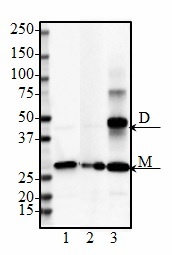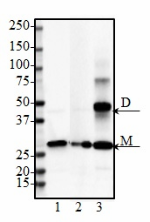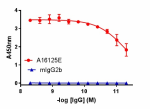- Clone
- A16125E (See other available formats)
- Regulatory Status
- RUO
- Other Names
- Protein DJ-1, oncogene, DJ1, PARK7, Parkinson disease protein 7, Parkinsonism-Associated Deglycase, HEL-S-67p, epididymis secretory sperm binding protein Li 67p, GATD2, Protein Deglycase DJ-1
- Isotype
- Mouse IgG2b, κ
- Ave. Rating
- Submit a Review
- Product Citations
- publications

-

Western blot of anti-DJ-1 antibody (clone A16125E). Lane 1: 20 µg of normal brain lysate; Lane 2: 20 µg of Parkinson's disease brain lysate; Lane 3: 20 ng of recombinant human DJ-1 protein that migrated as monomer (M) and dimer (D). The blot was incubated with 1 µg/ml of the primary antibody overnight at 4°C, followed by incubation with HRP labeled goat anti-mouse IgG (Cat. No. 405301). Enhanced chemiluminescence was used as the detection system. -

Direct ELISA of anti-DJ-1 antibody (clone A16125E) and isotype-matched control mouse IgG2b binding to plate-immobilized recombinant human DJ-1. ELISA was performed by coating wells with 100 ng of DJ-1 protein. The wells were then incubated with the primary antibody at 37°C for 45 minutes, followed by incubation with horseradish peroxidase labeled goat anti-mouse secondary antibody. TMB (3, 3', 5, 5' tetramethylbenzidine) was used as the detection system. -

IHC staining of anti-DJ-1 antibody (clone A16125E) on formalin-fixed paraffin-embedded normal (left panel) and Parkinson's disease (right panel) brain tissue. Following antigen retrieval using sodium citrate (Cat. No. 928502), the tissue was incubated with 5.0 µg/ml of the primary antibody at for one hour at room temperature. BioLegend's Ultra Streptavidin (USA) HRP Detection Kit (Cat. No. 929901) was used for detection followed by hematoxylin and bluing solution counterstaining, according to the protocol provided. The images were captured with a 40X objective. Scale bar: 50 µm.
| Cat # | Size | Price | Quantity Check Availability | Save | ||
|---|---|---|---|---|---|---|
| 851501 | 25 µg | $106 | ||||
| 851502 | 100 µg | $282 | ||||
DJ-1 (PARK7) belongs to the peptidase C56 family of proteins and is expressed in almost all human cells and tissues. DJ-1 is a multi-functional protein associated with mitochondrial function, mitophagy, and male fertility. It acts as an oxidative stress sensor, redox-sensitive chaperone and protease. Therefore, the protein has an important role in cell protection against oxidative stress and cell death. DJ-1 is also associated with prostate cancer, and specific mutations of the protein are linked to autosomal recessive, early onset Parkinson’s disease.
Product DetailsProduct Details
- Verified Reactivity
- Human
- Antibody Type
- Monoclonal
- Host Species
- Mouse
- Immunogen
- Recombinant Human DJ-1
- Formulation
- Phosphate-buffered solution, pH 7.2, containing 0.09% sodium azide.
- Preparation
- The antibody was purified by affinity chromatography.
- Concentration
- 0.5 mg/ml
- Storage & Handling
- The antibody solution should be stored undiluted between 2°C and 8°C.
- Application
-
WB - Quality tested
Direct ELISA, IHC-P - Verified - Recommended Usage
-
Each lot of this antibody is quality control tested by Western blotting. For Western blotting, the suggested use of this reagent is 1.0 - 5.0 µg per ml. For Direct ELISA, a concentration range of 0.002 - 1.0 µg/mL is recommended. For immunohistochemistry, a concentration range of 1.0 - 5.0 µg/ml is suggested. It is recommended that the reagent be titrated for optimal performance for each application.
- RRID
-
AB_2721732 (BioLegend Cat. No. 851501)
AB_2721732 (BioLegend Cat. No. 851502)
Antigen Details
- Structure
- Human DJ-1 is a 189 amino acid protein with an apparent molecular weight of 20 kD. The protein consists of 7 β-strands and 7 α-helices, and exits as a dimer.
- Distribution
-
Tissue distribution: Highly expressed in pancreas, kidney, skeletal muscle, liver, testis and heart. Detected at slightly lower levels in brain and placenta.
Cellular distribution: Mitochondria, nucleus, cytosol, plasma membrane, and extracellular. - Function
- DJ-1 functions as an oxidative stress sensor and redox-sensitive chaperone.
- Interaction
- PINK1, Parkin, EFCAB6/DJBP, OTUD7B, BBS1, HIPK1, CLCF1 and MTERF.
- Biology Area
- Cell Biology, Mitochondrial Function, Neurodegeneration, Neuroinflammation, Neuroscience, Neuroscience Cell Markers, Protein Misfolding and Aggregation, Protein Trafficking and Clearance
- Molecular Family
- Mitochondrial Markers
- Antigen References
-
1. Saito Y. 2014. J. Clin. Biochem. Nutr. 54(3):138-44. PubMed
2. Ariga H, et al. 2013. Oxid. Med. Cell Longev. 2013:683920. PubMed
3. Bonifati V, et al. 2003. Science (5604): 256–9. PubMed - Gene ID
- 11315 View all products for this Gene ID
- UniProt
- View information about DJ-1 on UniProt.org
Related FAQs
Other Formats
View All DJ-1 (PARK7) Reagents Request Custom Conjugation| Description | Clone | Applications |
|---|---|---|
| Purified anti-DJ-1 (PARK7) | A16125E | WB,Direct ELISA,IHC-P |
Compare Data Across All Formats
This data display is provided for general comparisons between formats.
Your actual data may vary due to variations in samples, target cells, instruments and their settings, staining conditions, and other factors.
If you need assistance with selecting the best format contact our expert technical support team.

 Login/Register
Login/Register 










Follow Us